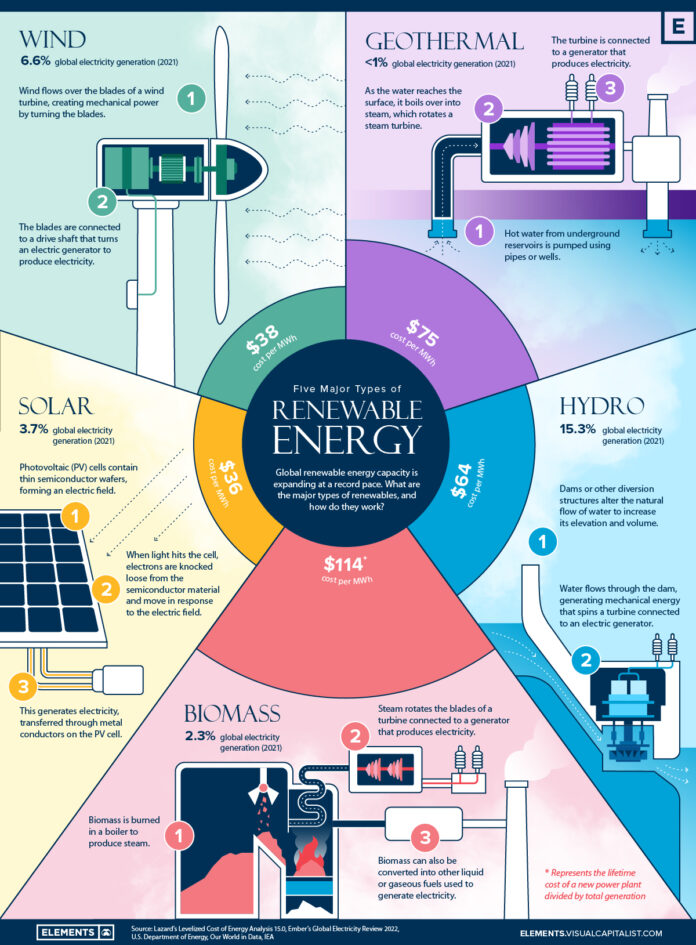The Renewable Energy Age
Climate change awareness is influencing the global economy in a variety of ways.
Governments are developing strategies to cut emissions, investors are examining corporate environmental performance, and consumers are becoming more aware of their carbon footprints. Energy generation and use from fossil fuels, regardless of the stakeholder, is one of the largest sources to emissions.
As a result, renewable energy sources have never been more prominent in the public consciousness than they are now.
The Five Types of Renewable Energy
Renewable energy systems capture the sun’s, wind’s, and heat from the Earth’s core and convert it into useable forms of energy such as heat, electricity, and fuel.
The infographic above outlines everything you need to know about the five main types of renewable energy using data from Lazard, Ember, and other sources.
| Energy Source | % of 2021 Global Electricity Generation | Avg. levelized cost of energy per MWh |
|---|---|---|
Hydro  |
15.3% | $64 |
Wind  |
6.6% | $38 |
Solar  |
3.7% | $36 |
Biomass  |
2.3% | $114 |
Geothermal  |
<1% | $75 |
Editor’s note: We have excluded nuclear from the mix here, because although it is often defined as a sustainable energy source, it is not technically renewable (i.e. there are finite amounts of uranium).
Hydro, which is often overlooked, is the most common renewable energy source, followed by wind and solar.
In 2021, the five major sources accounted for around 28% of worldwide electricity generation, with wind and solar breaking the 10% mark for the first time.
The levelized cost of energy (LCOE) is calculated by dividing the total electricity produced by the lifetime costs of a new utility-scale plant. Solar and wind have an LCOE of nearly one-fifth that of coal ($167/MWh), implying that new solar and wind projects are currently significantly cheaper to build and run over a longer time horizon than new coal plants.
In light of this, let’s take a deeper look at the five different types of renewable energy and how they work.
1. Wind
Wind turbines harness the kinetic energy provided by wind by using massive rotor blades set at high heights on both land and sea.
When wind blows across a blade, the air pressure on one side drops, drawing the blade down with a force known as the lift. The blades rotate as a result of the air pressure difference between the two sides, turning the rotor.
The rotor is attached to a turbine generator, which spins in order to convert the kinetic energy of the wind into electricity.
2. Solar (Photovoltaic)
Solar technologies convert sunlight into electricity by capturing light or electromagnetic radiation from the sun.
A semiconductor wafer, positive on one side and negative on the other, forms an electric field in Photovoltaic (PV) solar cells. When light strikes the cell, the semiconductor absorbs it and sends the energy to the cell’s electrodes in the form of electrons. The electric field, in the form of an electric current, captures these electrons.
The ability of a solar system to create energy is determined by the semiconductor material as well as ambient factors such as heat, dirt, and shade.
3. Geothermal
Geothermal energy comes directly from the Earth’s core, when heat from the core boils deep water reservoirs, creating geothermal resources.
Wells are primarily used to draw hot water from geothermal resources and convert it to steam for a turbine generator in geothermal plants. It is then possible to reintroduce the removed water and steam, making it a sustainable energy source.
4. Hydropower
Hydropower plants, like wind turbines, use a turbine generator to convert the kinetic energy of flowing water into electricity.
Hydro plants are often located near bodies of water and use diversion structures such as dams to alter water flow. The volume and change in elevation or head of the flowing water determine the amount of energy generated.
More energy and power are produced by larger water volumes and higher heads, and vice versa.
5. Biomass
Since our ancestors learned how to build fires, humans have most likely used biomass or bioenergy for heat.
Biomass, which consists of organic materials such as wood, dried leaves, and agricultural waste, is often burned but is considered renewable since it can be regrown or replaced. When biomass is burned in a boiler, high-pressure steam is produced, which rotates a turbine generator to generate power.
For transportation, biomass is also processed into liquid or gaseous fuels. However, biomass emissions vary depending on the material burned and are frequently higher than emissions from other clean sources.
When Will Renewable Energy Take Over?
Despite recent progress, fossil fuels continue to dominate the global energy mix.
The majority of countries are still in the early stages of their energy transition, and just a few have significant renewable energy sources. The current decade, on the other hand, may witness even greater growth than the recent record-breaking years.
The IEA forecasts that, by 2026, global renewable electricity capacity is set to grow by 60% from 2020 levels to over 4,800 gigawatts—equal to the current power output of fossil fuels and nuclear combined. So, regardless of when renewables will take over, it’s clear that the global energy economy will continue changing.
Source:https://www.visualcapitalist.com/what-are-the-five-major-types-of-renewable-energy/

